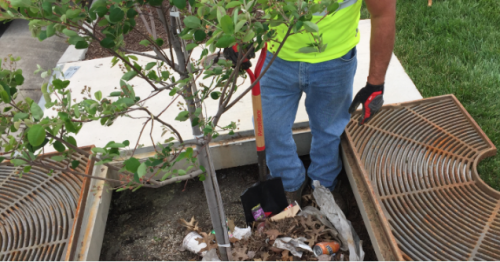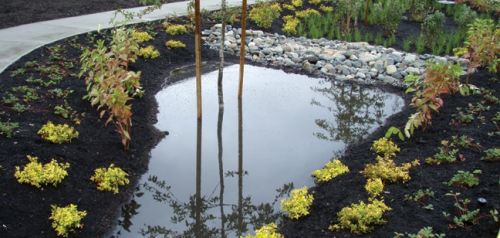Maintenance, Rehabilitation and Repair

Overview[edit]
The desired level of service for an individual BMP or an entire inspection and maintenance program encompasses the frequency and type of inspection and maintenance activities that will be undertaken. For example, will BMP inspections be done on an annual basis or more frequently for high priority/visibility ones? Will this vary based on the size and type of BMP, whether the practice is on public or private land, or other factors such as implications if treatment performance is not maintained (e.g., within drainage areas of sensitive receiving waters or species at risk habitat)? Will maintenance be performed in response to complaints or emergencies or will it be based on preset schedules and findings from routine inspections? The table below outlines several key level of service decisions that need to be made by a municipality prior to program design and is intended to help managers of stormwater infrastructure with planning for the future as their programs develop and evolve.
Level of Service |
BMPs Included |
Maintenance Tasks |
Maintenance Frequency |
Inspectors |
Inspection Frequency |
Feedback from Experience |
|---|---|---|---|---|---|---|
| BMPs on public land and within rights-of-way | Repair immediate threats to public health and safety | React to complaints and emergencies | Rely on owners/ managers or their contractors to inspect, maintain and keep track of records. | Complaint driven | Anecdotal | |
| + | + | + | Inspectors send reports to responsible party and municipality | Annual or semiannual | + | |
| High priority, high visibility, and/or large BMPs on private land within easements and covered by agreements | Repair structural items: clogged or broken parts, erosion problems | Establish preset schedule for routine inspection and maintenance tasks | Co-inspections with public inspector and responsible party or their consultants | More frequent for high priority BMPs | Feedback used to modify list of acceptable BMPs based on maintenance or performance record | |
| + | Routine mowing, weeding, remove trash and debris, replace vegetation; and, (+) |
+ | Periodic Maintenance and Performance Verification inspections | Maintenance Verification inspections every 5 years | + | |
| All or most BMPs on private land within easements and covered by agreements | Includes retrofitting or reconstructing BMPs; and, (+) |
Conduct structural repairs in response to Routine Operation, Maintenance and Performance Verification inspections | System of certified private inspectors | Performance Verification inspections every 15 years | Feedback used to modify municipal programs and BMP design guidance or standards | |
| Note: (+) denotes s that services are cumulative (level of service includes all previous tasks too). | ||||||
Responsibility of Maintenance Tasks[edit]
Check out the table below that highlights more examples of the differences between routine and structural maintenance tasks. One option for municipalities is to assign responsibility for routine maintenance tasks that are largely aesthetic in nature to the property owner while retaining responsibility for structural repairs. As municipal programs become more sophisticated, some routine maintenance tasks like sediment removal may be taken over by the municipality to avoid or prolong the need for more costly structural repairs.
Routine Maintenance Tasks |
Structural Repair Tasks |
|---|---|
|
|
Responsible Parties[edit]
Large municipalities and property management organizations with numerous properties and BMPs to maintain may choose to use in-house staff to conduct BMP maintenance. However, for small to medium-sized organizations, employing private contractors is often more efficient than hiring new staff and purchasing equipment. Another option is entering into an agreement with neighboring local municipalities, the upper-tier municipality or other property managers with stormwater BMPs to maintain to share responsibilities and maximize economies of scale in the use of equipment and personnel.
Tracking, Verifying & Enforcing Maintenance Requirements[edit]
For municipalities, enabling policies and program tracking and evaluation systems are key components of an effective stormwater BMP inspection and maintenance program. Before a development proposal is approved, each BMP in the SWM plan that contributes to meeting regulatory requirements should at a minimum, have an inspection and maintenance plan prepared and included in submissions for plan review and approval. Ideally, each BMP that contributes to meeting regulatory requirements should be part of an ECA or maintenance agreement that includes inspection and maintenance plans specific to each type of BMP in the associated site or subdivision plan.
When up-to-date inspection and maintenance records are not on file with the municipality and cannot be produced by the property owner, or a BMP is found through inspection to be inadequately maintained, mechanisms to enforce compliance with the conditions of the ECA or maintenance agreement must be in place going forward.
Approaches to Assigning Responsibilities[edit]
A critical policy decision facing municipalities regarding inspection and maintenance of stormwater infrastructure is who will be responsible, and for what types of tasks because the decision affects how the program will be designed. In general, there are three (3) approaches a community can use to implement a stormwater infrastructure inspection and maintenance program:

- Property Owner Approach: Property owners are responsible for performing all inspection, maintenance and repair/rehabilitation for BMPs on their properties and associated record keeping. The municipality provides inspection and maintenance plan templates, property owner outreach education resources and inspects, maintains and repairs BMPs on their land and within infrastructure rights-of-way. See this approach currently being considered by example CVC by utilizing Ontario's Drainage Act in future SWM plans with municipalities located within their watershed (CVC, 2021)[3].
- Public Approach: Municipality is responsible for performing or tracking inspection, maintenance and repair/rehabilitation of all BMPs that qualify for inclusion in their stormwater infrastructure program, whether located on public or private land (e.g., could include those implemented as part of a stormwater utility fee credit program or CSO abatement plan). See this approach currently being implemented in Mississauga under their Stormwater Charge which included a Stormwater Credit program for ICI and MUR properties within their jurisdiction. This charge program lists eligible LID BMPs to be considered for for meeting the stormwater credit requirements for peak flow reduction, runoff volume reduction and/or quality control (City of Mississauga, 2022)[4]
- Hybrid Approach: A hybrid approach consisting of both public and private entities responsible for various inspection, maintenance and repair tasks. An example of this approach currently being used is in Victoria, B.C. through their Rainwater rewards Program, which helps offset the cost for private property owners to implement one of their recognized LID BMPs. If homeowners are already managing rainwater on their properties they are eligible for further discounts (City of Victoria, 2022.)[2]
Typical Program Characteristics |
Strengths / Weaknesses |
|---|---|
| Property Owner Approach | |
|
Strengths:
|
| Public Approach | |
|
Strengths:
|
| Hybrid Approach | |
|
Strengths:
|
References[edit]
- ↑ Contech Engineered Solutions. 2021. Maintenance Considerations for High-Flow Bioretention Systems. The Stormwater Blog. October 12, 2021. Accessed 25 May 2022. https://www.conteches.com/stormwater-article/article/254/maintenance-considerations-for-high-flow-bioretention-systems
- ↑ 2.0 2.1 City of Victoria. 2022. Rainwater Rewards Program. Residents > Water, Sewer & Stormwater > Stormwater Management. Accessed 25 May 2022. https://www.victoria.ca/EN/main/residents/water-sewer-stormwater/stormwater/rainwater_rewards_program.html
- ↑ CVC. 2021. Drainage Act FAQ for Urban Municipalities. June, 2021. Accessed 25 May 2022. https://sustainabletechnologies.ca/app/uploads/2021/06/Drainage-Act-FAQ_06292021.pdf
- ↑ City of Mississauga. 2022. Stormwater Credit Program Review – Phase 2. Engineering Services under Contract 4600017285. Written by: Resilient Consulting Corporation. Project No. 2021-010 - January 2022. https://www.mississauga.ca/wp-content/uploads/2022/02/17144148/Stormwater-Credit-Review-Report-2021.pdf
